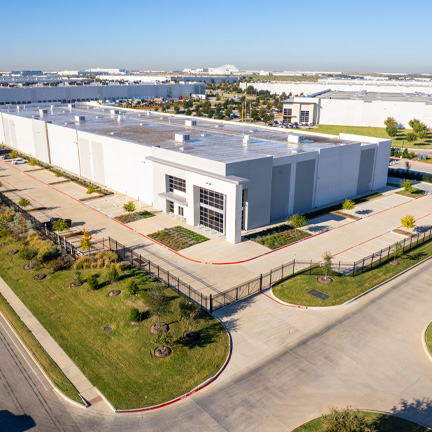Press

CenterPoint Properties Acquires Newly Constructed Fort Worth Distribution Facility
Search Site
Back to Menu

“This year, I expect us [CenterPoint Properties] to spend anywhere between $200 million to $250 million investing in the Chicago market, which is about the same amount we spent last year."
- Brian McKiernan, Senior Vice President of Development in the Central Region
Read what Brian and other experts had to say about what’s driving industrial real estate demand and where the hotspots are in the Chicago market for investment and development in “Why the Chicago industrial market’s hot streak isn’t cooling down anytime soon.”
If local industrial investment activity ends the year like Faropoint started it, 2022 will be a stellar one for this property type.
Since January, the real estate investment company, which has headquarters in New Jersey and Israel, has acquired 11 Chicago-area buildings totaling 390,000 square feet, boosting its national portfolio to 31 buildings and 1.8 million square feet, according to Jordan Kovalsky, senior vice president of Midwest markets for Faropoint.
She added that Faropint invested $120 million in the Chicago market last year and plans to invest another $150 million to $200 million across the region in 2022.
“Chicago is a strong market for industrial investors, and that’s why we are investing so much in this market,” said Kovalsky.
The Chicago industrial market had a record-breaking year in 2021 across all market fundamentals and has continued that momentum this year, according to the JLL’s 2022 Midwest Industrial Outlook Report.
The report concluded that e-commerce continued to drive demand, fueling growth in support industries, including warehouse and distribution as well as paper and packaging companies. Auto and food processing distributors also remained robust.
Meanwhile, despite supply-chain challenges, development continues to flourish, with more than 20 million square feet built in 2021, the report said — marking the third year in a row that deliveries exceeded 20 million square feet. Infill development also continues to be robust, with land pricing hitting all-time highs.
The total vacancy rate continued to decrease, falling to 2.4% last year, as year-over-year rent growth surged 17%, largely driven by logistics and distribution and third-party logistics (3PL) companies, the report found.
“The first quarter is usually the slowest quarter for the year, but in Chicago 15 million square feet was leased during that time,” said George Cutro, director of industrial research for JLL. “And in Chicago, net lease rates were $5.87 per square feet, which is up 5% from the previous quarter.”
Jordan Kovalsky, senior vice president of Midwest markets for Faropoint, said her firm plans to invest up to $200 million in industrial properties in the Chicago market this year.
Further demonstrating the demand for industrial space is the fact that nearly half of properties currently under construction in Chicago — 45.6% — comprise more than 750,000 square feet, according to Avison Young’s Q1 Chicago Industrial Market Report.
“As construction costs increase, industrial products under 300,000 square feet are becoming cost-prohibitive to develop,” said Faropoint’s Kovalsky.
Once it’s built, however, “industrial property is often less expensive to maintain than office or retail because it’s not a lot of capital expenses other than a parking lot and probably office improvements over time,” she added.
A ‘perfect storm’
The historic demand for industrial real estate across Chicago and the country has accelerated during the pandemic, which JLL’s Cutro called a “perfect storm” for industrial.
“What the pandemic did was change how we store and buy products, and that has led to a demand for more storage facilities,” he said. “It created a huge boost in absorption of industrial space, especially warehouse space. What is happening is products sold at retail stores are now being stored at warehouses since more people shop online as opposed to going into a store to make their purchases.”
The supply-chain crisis, too, has increased industrial demand, added Brian McKiernan, senior vice president of development for the Central Region for CenterPoint Properties.
“Inventory management has changed too,” he said. “Storage space is very important now that it’s become harder to get products imported into the United States. General contractors are stacking up materials like cement and lumber more abundantly to ensure it won’t have to wait weeks and weeks for materials before it can begin a job.”
Two Chicago areas that McKiernan said are hot for industrial investors are the O’Hare and I-55 corridors.
“Those two areas are good regional locations for industrial, and I think it will remain that way for the rest of the year,” he said. “This year, I expect us [CenterPoint Properties] to spend anywhere between $200 million to $250 million investing in the Chicago market, which is about the same amount we spent last year.”
About CenterPoint Properties
CenterPoint is an industrial real estate company made up of dedicated thinkers, innovators and leaders with the creativity and know-how to tackle the industry’s toughest challenges. And it’s those kinds of problems — the delicate, the complex, the seemingly impossible — that we relish most. Because with an agile team, substantial access to capital and industry-leading expertise, those are exactly the kinds of problems we’re built to solve. For more information on CenterPoint Properties, follow us on LinkedIn. For all media inquiries, including requests for interviews with CenterPoint executives, please contact media@centerpoint.com or 630.586.8285.
For CenterPoint Investment, Development, and Asset Management inquiries, please contact:
Subscribe
Microsite Request